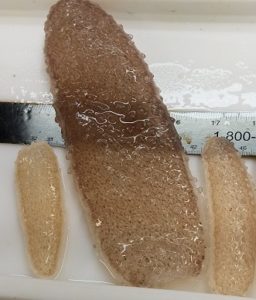
Millions of glowing, tube-shaped sea creatures known as pyrosomes have invaded the coast of the Pacific Northwest of the US and Canada. Due to their exploding populations on the west coast of US, to Alaska and British Columbia in Canada, these strange-looking creatures are quickly becoming a problem for fishermen as they clog their hooks and fill up the fishing nets, but have no commercial value.
Pyrosomes are tubular marine creatures that are technically tunicates. They can be described as colonies of zooids that survive on plankton and other small organisms. They are made up of a bundle of organisms, so closely packed together, that they appear like a single marine creature. They are bioluminescent and therefore can glow in sea waters (thus getting the name “fire bodies”). Their body is translucent and gelatinous like jellyfish. Sometimes, people mistake them for sponges or jellyfish, but they are totally different from such creatures. They are typically found in warm tropical waters (like the Mediterranean Sea or near Australia). They are generally 3 to 60 cm in length, but sometimes, they can grow huge in size, about 60 feet in length. Those currently spotted along the seas off the coast of British Columbia and Alaska are cucumber-sized.
Michael Milstein, in a post on the National Oceanic and Atmospheric Administration’s (NOAA) Northwest Fisheries Science Center website, describes the growing numbers of these creatures as “invasion of the pyrosomes.” They were first seen in the region in spring, but can now be spotted all over the region in huge numbers. Their appearance is disturbing for fishermen as these creatures can potentially destroy a fragile food network. Many fishermen in the region have been facing difficulty accessing their normal catch, and are returning with huge numbers of pyrosomes instead of fishes.
In California, they were being spotted for the past few years, especially in areas around Cape Mendocino in Northern California and south of Point Conception. But, now they have appeared in huge numbers off the coast of Southern California.
“We have a lot of questions and not many answers,” Ric Brodeur of the Northwest Fisheries Science Center’s research station in Newport, Oregon stated in a post on the center’s site.
“We’re trying to collect as much information as we can to try to understand what is happening, and why.”
Recently, scientists from Ocean Networks Canada at the University of Victoria posted a video showing how these cucumber-like bodies have increased the thickness of the waters. Scientists with the National Oceanic and Atmospheric Administration recently captured over 93,000 pyrosomes off Southern California—the biggest local catch ever.
Researchers are surprised by the phenomenon, and believe changes in marine ecosystems or food chains or global warming could be the reason behind it. According to some researchers, an anomalous huge “blob” of warm water in the Pacific from 2014 to 2016 might be the reason behind appearance of these swarms.
“It’s really weird,” Jennifer Fisher, a faculty research assistant with Oregon State University’s Hatfield Marine Science Center, told National Geographic. “I’ve never seen anything like it.”
A joint team of researchers from NOAA Fisheries’ Northwest Fisheries Science Center, Oregon State University, and the University of Oregon is now looking into this phenomenon, and hopes to unravel the mystery whey these organisms have appeared in huge numbers in recent months.